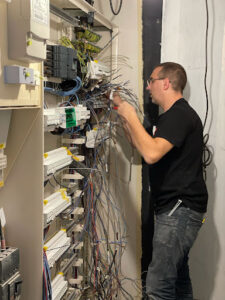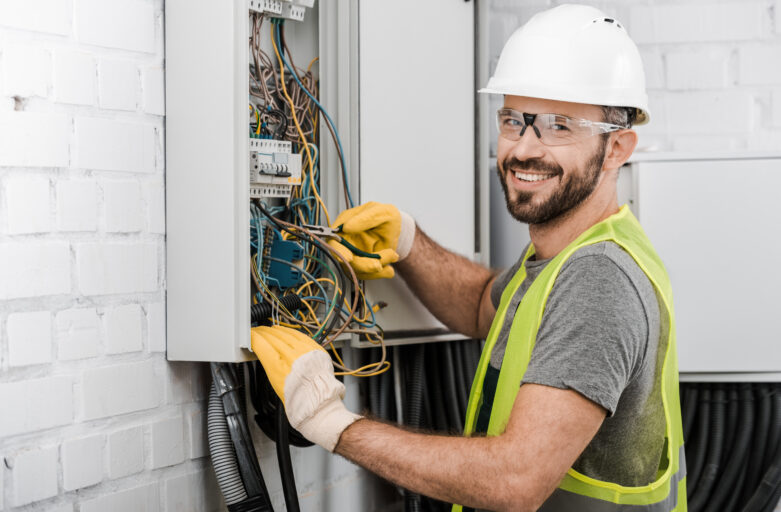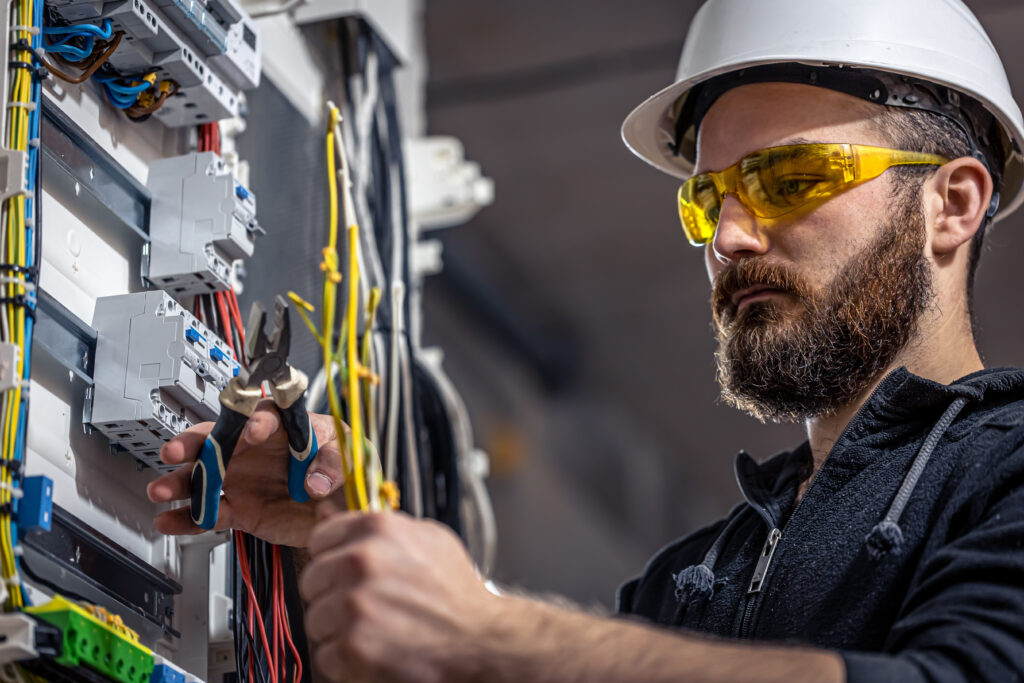Electrical contractors are the backbone of our electricity infrastructure. Their work ensures that when a power outage occurs, skilled electricians are on hand to restore it.

To become an electrician, you’ll need to attend classes at a trade and vocational school and then complete an apprenticeship under a master electrician. These programs can take 4-5 years to complete. Visit https://www.ampi-electricinc.com/ for more information.
Electrical work involves electricity, which is incredibly dangerous and can kill people. Electricians must follow strict safety guidelines and take many precautions when working with electricity. This includes using insulated tools, turning off all power sources before beginning work, and checking to ensure the area is safe before starting work. Never working alone when performing electrical work is also a good idea. This way, someone will be around to help if something goes wrong.
While working with electricity, it is important to stay away from overhead power lines. These lines are usually live, and touching them can lead to electrocution. If you see a downed power line, you should not touch it and should call your electricity provider immediately. If you do have to be near a downed power line, you must stay in your vehicle and wait for the utility company to arrive.
Another aspect of electrician safety is wearing the proper protective gear. This includes face masks and gloves when handling chemicals, working in extreme temperatures and dealing with UV radiation during welding. Electricians must also wear proper footwear when walking on uneven ground or standing in one position for extended periods of time. This can cause back and leg strain.
A major issue faced by electricians is exposure to lead and solvents. This can be from paint, solder or cleaning products used on the job. These solvents and chemicals can cause a variety of health issues, including cancer.
One of the most common hazards of being an electrician is getting shocked by uninsulated wires. This can happen if you aren’t careful, even if the power is turned off. It is important to always use insulated tools when working with electricity, and to never touch a live wire.
Other safety issues include working near water and fire. Electricians should always wear rubber boots when working in these areas. They should also wear flame-retardant clothes when working with hazardous materials such as lead or mercury. Finally, it is important for electricians to be careful when climbing ladders. They should avoid using ladders made of aluminum or steel, as these are conductors and could cause an electrical shock. Instead, they should use wooden or fiberglass ladders, which do not conduct electricity.
Communication
Whether they’re working on power, telecommunications or other types of infrastructure, electricians perform important work that contributes to our everyday lives. However, like many other tradespeople, they face a variety of communication challenges. Mastering effective communication skills can help them understand their clients better, work safely, and efficiently, solve problems quickly, and foster strong customer relationships.
One of the most common communication issues faced by electricians is that of misinterpretation or misunderstanding. As such, it’s critical to communicate clearly and concisely, avoiding technical jargon and using layman’s terms when explaining complicated concepts. It is also helpful to utilize visual aids such as diagrams, charts and images when possible to further facilitate comprehension.
The nature of their work often requires electricians to travel to various job sites, which can be difficult for them if they live far from their places of employment. Additionally, their work schedule is not set in stone and can change at any time due to unforeseen emergencies or last-minute repairs. As such, it’s crucial for electricians to keep their supervisors apprised of the status of their projects and any issues that may arise.
Depending on the type of project, an electrician may be required to collaborate with a team of architects, engineers, construction workers, and others involved in the process. It’s important for these professionals to communicate effectively with each other and with clients to ensure that projects meet specifications and are completed in a timely manner.
It is also essential for electricians to keep their supervisors and clients informed about project progress, schedules and any changes that occur. Furthermore, it is crucial to maintain an organized work environment to ensure that all files are readily available to each member of the electrical team.
When dealing with a demanding or disgruntled client, it’s important for an electrician to remain calm and professional. If the situation becomes tense, it is recommended that the individual takes a step back and ask for assistance from their supervisor. This way, the problem can be dealt with in a more appropriate and controlled manner and the client will receive the best service possible.
Customer Service
Electricians face a variety of challenges when it comes to customer service. Many of their services require extensive interaction with customers, including discussing electrical needs, explaining potential risks and solutions, and providing on-site work. These interactions can pose customer service challenges if electricians are unfriendly or unhelpful, but they can also be improved with the use of software tools designed to enhance the customer experience.
For example, allowing customers to track the status of their electrical services via real-time service tracking or an online knowledge base helps them stay informed and reduces frustration when unexpected issues arise. Additionally, ensuring that customers are able to contact an electrician around the clock through a phone hotline or online chat empowers them to seek assistance when needed.
Using social media to showcase customer service successes can also help attract new business and reinforce customer satisfaction. For example, sharing videos of electricians fixing specific problems demonstrates your expertise in the field and gives potential clients a glimpse into what to expect from working with you.
In addition, offering discounts and rewards to loyal customers can help you grow your client base while strengthening existing relationships. The more satisfied a customer is, the more likely they are to refer you to others.
One of the biggest challenges electricians face is turning inquiries into bookings. Many customers aren’t familiar with the electrical services industry and may have questions about pricing, schedules, and procedures. Providing these answers via a dedicated FAQ page on your website can help you attract more leads and make the booking process easier for both you and the customer.
Another way to improve your customer service is to upsell services. For instance, a customer may call you to fix an electrical issue, but once they see your professionalism and expertise, they may trust you with additional projects, such as installing home theater systems or water heaters.
Providing exceptional customer service can set you apart from your competition, resulting in repeat business and referrals. To improve your customer service skills, consider hiring a skilled electrician to train you and equipping them with software tools to ensure a seamless customer experience.
Problem Solving
Electricians use logical problem-solving abilities to identify, assess and repair electrical issues. They understand how to interpret blueprints, diagrams and technical specifications and are aware of all local building codes and safety regulations. They are also able to test and analyze the performance of electrical systems in homes, businesses and factories to ensure they are functioning properly.
As a result, electricians must be critical thinkers and able to make accurate and effective decisions on their feet in challenging work environments. They must be able to perform physical labor in tight spaces for long periods of time and are often required to move, lift and carry heavy components weighing up to 50 pounds. They must have the ability to climb ladders, maneuver in confined areas and stand or kneel for extended periods of time while working with high voltage equipment.
The first step in solving a problem is to clearly define the issue itself. This requires researching the matter to identify its exact nature, including discovering the possible causes. Depending on the issue, this research may include interviewing those involved in the matter to understand the cause more thoroughly. This research is also used to create contingency plans that can be implemented if the initial solutions are not effective.
Once an electrician has a clear understanding of the problem at hand, they must then begin creating potential solutions. This involves brainstorming and applying various problem-solving models to the situation. It also involves assessing the effectiveness of each solution and determining what resources are available to implement the chosen solution.
It is important for an electrician to be able to identify wires by color, as well as the specific markings printed on their insulation. This is crucial to ensuring that the right wires are connected to the correct power sources and devices and that dangerous combinations are not created. Additionally, an electrician must be able to read and follow detailed wiring schematics. These diagrams often require a level of knowledge that is beyond what an average person can acquire through self-study, which is one reason why on-the-job experience is such a vital part of an apprenticeship program.

